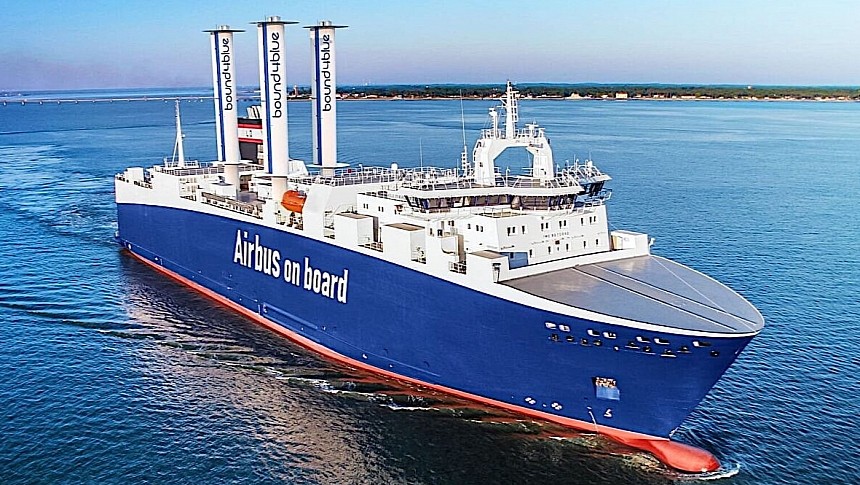With soaring fuel prices and the ever-looming danger of irreversible climate change hanging over our heads, the race to cut down fuel consumption in all aspects of a business is heating up. It does so to such a degree that we'll soon even have sail-powered ships of all shapes and sizes on our hands, including Ro-Ro ones.
A Ro-Ro ship is designed to carry wheeled cargo. We at times call them ferries, and they are the ones that move about cars, train cars, and even aircraft components. They are crucial to keeping factories and the world supplied and on the go. Because of the immense load they're capable of carrying, they also eat up a lot of fuel.
European airplane maker Airbus uses several such ships to move aircraft parts around. One of them is the Ville de Bordeaux, owned by Louis Dreyfus Armateurs, used to transport A320 aircraft subassemblies from Europe to the U.S.
The ship was completed in 2004 at the end of a $30 million investment. It can carry over 21,500 gross tons of cargo, and it's powered by diesel engines. Like all boats of its kind, it needs a lot of fuel to move from place to place.
In a bid to cut down on fuel expenses, Airbus announced this week the Ville de Bordeaux will get… sails. True, not just any sails, but a new technology made by Spanish company bound4blue.
The tech is called eSail, and it's not exactly a sail as we know the concept. It looks more like a mast 22 meters (72 feet) tall than an actual sail. It comprises a suction fan to draw air in, a suction area to allow air in, a flap to alter the aerodynamic shape of the sail and cover the suction area when not in use, and a rotation system that allows the mast to always face the wind.
The design, already deployed on three other ships, has proven it can generate up to seven times more lift than conventional rigid sails, helping the ships it is fitted on move ahead with no engine power.
By the looks of it Airbus plans to install three of them on the Ville de Bordeaux. It will do so in early 2024, when it will also start a six-month monitoring period to see how the technology performs.
The goal is to have this transport ship contribute to Airbus' plan of cutting its maritime operations CO2 emission levels in half by 2030, compared to 2015 levels. The eSails should help it do that by cutting up to 1,800 tons of CO2 each year from this ship alone.
The fitting of the tech on this kind of ship also marks the first time the eSail has been deployed on a boat this large. While Airbus will focus on how much fuel the tech can save it, bound4blue is itching to show the world its idea can work on high-weather deck ships without affecting stability.
European airplane maker Airbus uses several such ships to move aircraft parts around. One of them is the Ville de Bordeaux, owned by Louis Dreyfus Armateurs, used to transport A320 aircraft subassemblies from Europe to the U.S.
The ship was completed in 2004 at the end of a $30 million investment. It can carry over 21,500 gross tons of cargo, and it's powered by diesel engines. Like all boats of its kind, it needs a lot of fuel to move from place to place.
In a bid to cut down on fuel expenses, Airbus announced this week the Ville de Bordeaux will get… sails. True, not just any sails, but a new technology made by Spanish company bound4blue.
The tech is called eSail, and it's not exactly a sail as we know the concept. It looks more like a mast 22 meters (72 feet) tall than an actual sail. It comprises a suction fan to draw air in, a suction area to allow air in, a flap to alter the aerodynamic shape of the sail and cover the suction area when not in use, and a rotation system that allows the mast to always face the wind.
The design, already deployed on three other ships, has proven it can generate up to seven times more lift than conventional rigid sails, helping the ships it is fitted on move ahead with no engine power.
By the looks of it Airbus plans to install three of them on the Ville de Bordeaux. It will do so in early 2024, when it will also start a six-month monitoring period to see how the technology performs.
The goal is to have this transport ship contribute to Airbus' plan of cutting its maritime operations CO2 emission levels in half by 2030, compared to 2015 levels. The eSails should help it do that by cutting up to 1,800 tons of CO2 each year from this ship alone.
The fitting of the tech on this kind of ship also marks the first time the eSail has been deployed on a boat this large. While Airbus will focus on how much fuel the tech can save it, bound4blue is itching to show the world its idea can work on high-weather deck ships without affecting stability.






